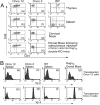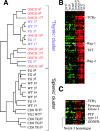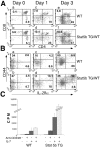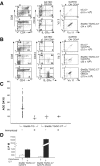Stat5 synergizes with T cell receptor/antigen stimulation in the development of lymphoblastic lymphoma
- PMID: 12835478
- PMCID: PMC2196089
- DOI: 10.1084/jem.20021548
Stat5 synergizes with T cell receptor/antigen stimulation in the development of lymphoblastic lymphoma
Abstract
Signal transducer and activator of transcription (STAT) proteins are latent transcription factors that mediate a wide range of actions induced by cytokines, interferons, and growth factors. We now report the development of thymic T cell lymphoblastic lymphomas in transgenic mice in which Stat5a or Stat5b is overexpressed within the lymphoid compartment. The rate of lymphoma induction was markedly enhanced by immunization or by the introduction of TCR transgenes. Remarkably, the Stat5 transgene potently induced development of CD8+ T cells, even in mice expressing a class II-restricted TCR transgene, with resulting CD8+ T cell lymphomas. These data demonstrate the oncogenic potential of dysregulated expression of a STAT protein that is not constitutively activated, and that TCR stimulation can contribute to this process.
Figures








Similar articles
-
Characterization of the roles of STAT1 and STAT3 signal transduction pathways in mammalian lens development.Mol Vis. 2004 Feb 19;10:122-31. Mol Vis. 2004. PMID: 14978477
-
Simultaneous, bidirectional inhibitory crosstalk between PPAR and STAT5b.Toxicol Appl Pharmacol. 2004 Sep 15;199(3):275-84. doi: 10.1016/j.taap.2003.12.020. Toxicol Appl Pharmacol. 2004. PMID: 15364543
-
Haploinsufficiency identifies STAT5 as a modifier of IL-7-induced lymphomas.Oncogene. 2005 Aug 4;24(33):5252-7. doi: 10.1038/sj.onc.1208726. Oncogene. 2005. PMID: 15870688
-
Coactivators in gene regulation by STAT5.Vitam Horm. 2005;70:359-86. doi: 10.1016/S0083-6729(05)70012-1. Vitam Horm. 2005. PMID: 15727811 Review.
-
Signal transducer and activator of transcription (STAT) signalling and T-cell lymphomas.Immunology. 2005 Mar;114(3):301-12. doi: 10.1111/j.1365-2567.2005.02091.x. Immunology. 2005. PMID: 15720432 Free PMC article. Review.
Cited by
-
New insights into the roles of Stat5a/b and Stat3 in T cell development and differentiation.Semin Cell Dev Biol. 2008 Aug;19(4):394-400. doi: 10.1016/j.semcdb.2008.07.011. Epub 2008 Jul 30. Semin Cell Dev Biol. 2008. PMID: 18708155 Free PMC article. Review.
-
NK cells prevent T cell lymphoma development in T cell receptor-transgenic mice.Cell Immunol. 2020 Jun;352:104081. doi: 10.1016/j.cellimm.2020.104081. Epub 2020 Feb 27. Cell Immunol. 2020. PMID: 32143838 Free PMC article.
-
Pre-Clinical Evaluation of the Hypomethylating Agent Decitabine for the Treatment of T-Cell Lymphoblastic Lymphoma.Cancers (Basel). 2023 Jan 20;15(3):647. doi: 10.3390/cancers15030647. Cancers (Basel). 2023. PMID: 36765607 Free PMC article.
-
The biological functions of the versatile transcription factors STAT3 and STAT5 and new strategies for their targeted inhibition.J Mammary Gland Biol Neoplasia. 2006 Jan;11(1):75-87. doi: 10.1007/s10911-006-9014-4. J Mammary Gland Biol Neoplasia. 2006. PMID: 16947086 Review.
-
High-resolution Antibody Array Analysis of Childhood Acute Leukemia Cells.Mol Cell Proteomics. 2016 Apr;15(4):1246-61. doi: 10.1074/mcp.M115.054593. Epub 2016 Jan 19. Mol Cell Proteomics. 2016. PMID: 26785729 Free PMC article.
References
-
- Stark, G.R., I.M. Kerr, B.R. Williams, R.H. Silverman, and R.D. Schreiber. 1998. How cells respond to interferons. Annu. Rev. Biochem. 67:227–264. - PubMed
-
- Leonard, W.J., and J.J. O'Shea. 1998. Jaks and STATs: biological implications. Annu. Rev. Immunol. 16:293–322. - PubMed
-
- Darnell, J.E., Jr. 1997. STATs and gene regulation. Science. 277:1630–1635. - PubMed
-
- Bowman, T., R. Garcia, J. Turkson, and R. Jove. 2000. STATs in oncogenesis. Oncogene. 19:2474–2488. - PubMed
-
- Migone, T.S., J.X. Lin, A. Cereseto, J.C. Mulloy, J.J. O'Shea, G. Franchini, and W.J. Leonard. 1995. Constitutively activated Jak-STAT pathway in T cells transformed with HTLV-I. Science. 269:79–81. - PubMed
MeSH terms
Substances
LinkOut - more resources
Full Text Sources
Other Literature Sources
Molecular Biology Databases
Research Materials
Miscellaneous

